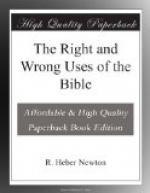The popular religion was that composite of heathenisms already sketched in considering the previous period. The people continued to worship the Power which all felt and owned, under the manifold forms which this Power assumes in nature’s processes. Sun and moon and stars still arrested the awe which through them groped after God, and drew upon themselves the worship of the imagination. The worship of Jehovah had a special honor as the State religion, but it stood contentedly amid other forms of religion. In the service of Jehovah local shrines developed special usages. The “Uses” of Israel were as varied as the “Uses” of England before the Reformation. No act of Uniformity was in operation in the realm. Idolatry was not the exception but the rule. The most popular symbol of Jehovah was an image of a bull. To the higher minds this bull was doubtless merely a symbol, expressive of a striking phase of the sun’s force, but to the mass of men it was probably the actual object of their adorations. The symbolism of the Jerusalem Temple was thoroughly idolatrous; as, for example, the twelve oxen upholding the laver, and the horns of the altar, symbols drawn from the prevalent bull-worship; the two columns in the court, and the cherubs, or cloud-dragons in the most holy place; the chamanim, or sun-images representing the rays of the sun in the shape of a cone, and the chariots and horses of the sun, a very ancient symbol familiar to us in Guido’s Aurora.[43]
Nor did the allegiance to Jehovah bar private usages of an idolatrous nature. The home of the average Israelite had its teraphim and other domestic divinities. The darker aspects of the popular religion still held their ground against the growing light. Beneath the shadow of the Jehovah of the Ten Words, stood, unmolested, the images fashioned by the appetites and passions; and men and women surrendered themselves to drunken orgies and sensual debauches, in honor of the deities of desire. As late as the time of Jeremiah, after nearly two centuries of prophetic teaching, there were in the sacred precincts of the temple the asheras, or tree-poles, by which the priestesses of passion, as part of their religious offices, sold themselves to the frequenters of Jehovah’s house.[44] Below the holy city, King Manasseh reared the image of Moloch, and human sacrifices were offered to placate the wrath of the Power which they ignorantly worshipped.
Where religion was so largely a worship of the physical powers of nature, the life of the people would of necessity show an undeveloped ethical state. Drunkenness and debauchery continued common, the marriage bond was very elastic in the polite society of the capital, and selfishness haughtily overrode all considerations of meum and tuum in the mad chase of wealth.
Unsatisfactory as the morals of the influential classes of society were, there is, however, no indication of any such “ooze and thaw of wrong” as indicated a moribund condition in the nation.




